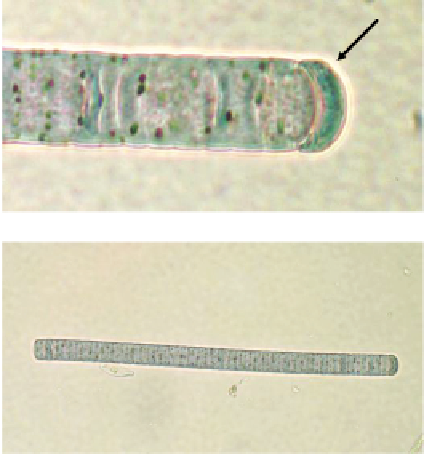Environmental Engineering Reference
In-Depth Information
Trichomes may be (1) straight or bent, (2)
single or in groups, (3) free-floating or
attached, (4) short or quite long, (5) capa-
ble of a gliding movement or a gentle wav-
ing (oscillatory movement), (6) blue-green,
olive green, reddish or brownish in colour.
Free-floating forms commonly have gas vac-
uoles. Cells 1-60 μm wide, either longer or
usually shorter than broad. The cell cross
walls may or may not be narrowed, depend-
ing upon species, as may the presence or
absenceofacalyptraontheendcellofthetri-
chome. The end cell may be rounded or have
a characteristic shape. Reproduction occurs
by the trichome fragmenting into short
hormogonia.
25 μm
50 μm
Anagnostidis and Komarek (1985) sep-
arate several genera from
Oscillatoria
,
including:
Tychonema
- with species
T. bornetii
and
T. bourrellyi
(formally
Oscillatoria
bornetii
and
O. bourrellyi
) are separated
mainly on the basis of the cells containing
numerous liquid-filled vacuoles;
Planktothrix - P. agardhii, P. rubescens
and
P. prolifica
(formally
Oscillatoria
agardhii, O. rubescens
and
O. prolifica)
)
are all species with narrow cells.
Limnothrix
-
L. redekei
,
(
Oscillatoria
redekei
), which has gas vacuoles localised
either side of the cross walls.
Figure 4.27
Oscillatoria
. Top: Detail showing cap
cell (arrow) at the end of filament. Bottom: Single, free
floating filament. This species has a distinctive purple
coloration.
55
(54) (a) Trichomessingleorgrouped.Sheathdel-
icatebutirm(rarelythick).......
Lyngbya
Trichomes of
Lyngbya
are a single row
of cells enclosed in a fairly firm sheath.
Trichomes may be solitary or form a
coiled or tangled mass, free-floating or
growing on a substrate. The sheaths may
become yellowish-brown through staining
with chemicals in the water. False branch-
ing has been occasionally reported. Cells
1-24 μm diameter. Hormogonia may be
formed. Larger species of
Lyngbya
may
be confused with
Oscillatoria
,
especially if
the former has migrated out of its sheath.
Lyngbya
can produce a range of toxins in
water such as aplysiatoxin, lyngbyatoxin-a,
saxitoxin and lypopolysaccharides (Chorus
& Bartrum, 1999). Cyanophyta. Plate VII.
Fig. 4.28.
Several species are reported to produce
taste and odour in water used for drinking
purposes (Palmer, 1962). When present in
large numbers, it can clog filters used in
water treatment processes. Some members
of the
Oscillatoria
group are known to pro-
duce toxins such as microcystins, anatoxin-
a, lipopolysaccharides and aplysiatoxins
(Chorus and Bartrum, 1999). Cyanophyta.
Plate VIII. Fig. 4.27.
(b) Trichomes surrounded by a sheath . .
55




Search WWH ::

Custom Search